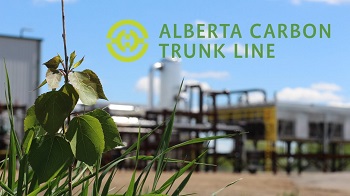A new system built to safely transport and permanently store CO2 is shifting how carbon is managed in the province. The Alberta Carbon Trunk Line (ACTL) system, the world's newest large-scale carbon capture, utilization, and storage (CCUS) project, is now fully operational.
The ACTL system captures industrial emissions and delivers the CO2 to mature oil and gas reservoirs in Central Alberta for use in enhanced oil recovery and permanent storage.
The current supply of CO2 is captured at the North West Redwater Partnership (NWR) Sturgeon Refinery and Nutrien’s Redwater Fertilizer Facility, offering a sustainable emissions solution for energy and agriculture sectors. The CO2 then travels down a 240-kilometer pipeline, which is owned by Wolf Midstream, to a storage reservoir owned by Enhance Energy.
The system includes the world’s largest capacity pipeline for CO2 from human activity, capable of transporting up to 14.6 million tons of CO2 per year. Designed with excess capacity, the system will connect more facilities and storage reservoirs in the future as demand increases for an effective solution to manage emissions.
“This is just the beginning,” said Jeff Pearson, President of Wolf Midstream’s Carbon Business Unit. “This critical piece of infrastructure supports significant future emissions solutions, new utilization pathways and innovation in the carbon capture space. The future of energy and a lower carbon economy relies on key infrastructure like the ACTL.”
“This will change how business is done in Alberta,” said Kevin Jabusch, CEO of Enhance Energy, which is injecting CO2 from the ACTL into oil fields near Clive, Alberta. “We are putting CO2 to use. We permanently keep CO2 out of the environment, while producing low-carbon energy. Not only are we reinvigorating our rural energy economy at a time when it is needed most, but we are playing a key role in advancing a sustainable solution to global energy requirements.”
“The Sturgeon Refinery made a bold decision over 15 years ago to incorporate carbon capture into its design,” said Kerry Margetts, President, NWR Sturgeon Refinery, “Our founders believed then, as we are proving today, that carbon capture was our environmental competitive advantage to producing a low carbon intensity diesel from Alberta’s bitumen resources.”

